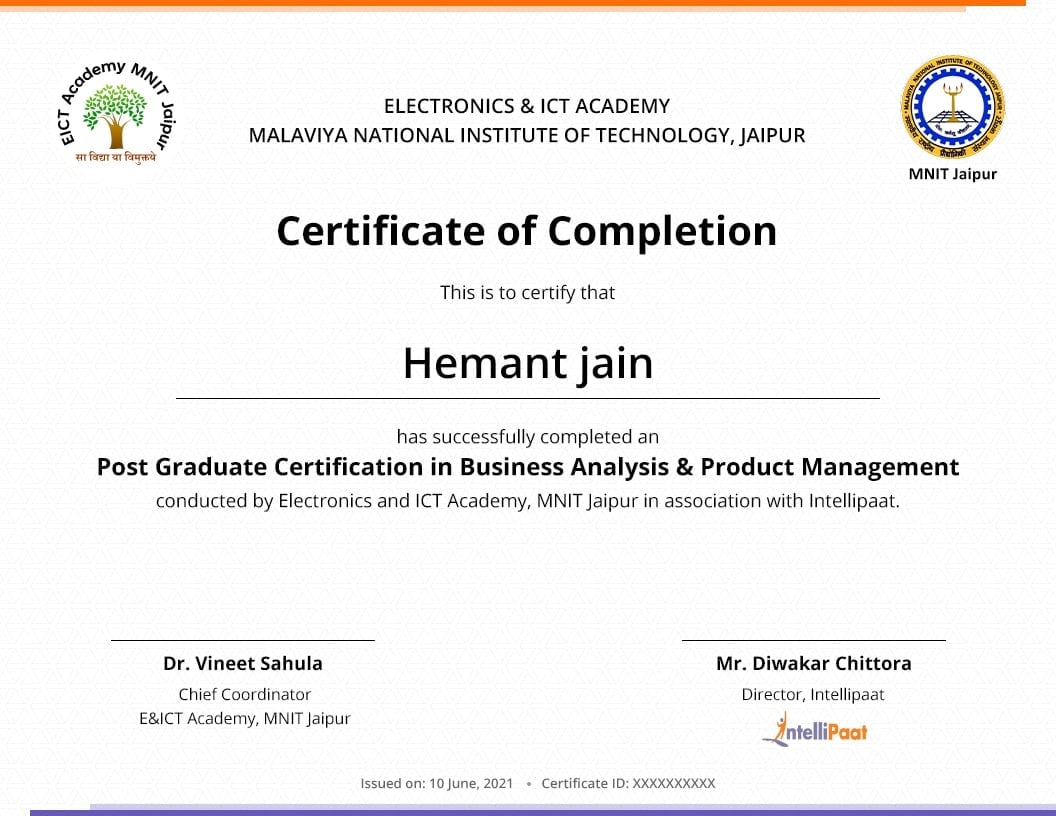Your cart is currently empty.







This Post Graduate Certification in Business Analysis & Product Management by E&ICT Academy, Malviya National Institute of Technology (MNIT), Jaipur will provide extensive training on Agile methodologies, Tableau, SQL for business analytics, etc. and with a focus on industry-based projects for hands-on experience. This course includes the modules of IIBA CBAP & CBDA certification. The course has been carefully brought together by industry experts & top faculty at MNIT.
Learning Format
Online
Live Classes
7 Months
Career Services
by Intellipaat
Placement Assistance
Interviews
EMI Starts
at ₹4999/month*
This Post Graduate Certification program has been designed to help one become an expert in the field of business analysis and product management with intensive training provided by the MNIT, Jaipur faculty. The skills have been carefully picked for our learners to add value to their resumes and help meet the rising demands in the industry.
About E&ICT MNIT, Jaipur
Electronics & ICT Academy MNIT, Jaipur (E&ICT MNIT, Jaipur) is an initiative supported by the Ministry of Electronics & Information Technology (MeitY), Govt of India. The courses lay an emphasis on bridging the gap between industry demand and academic approach to learning and provide a foundation to build your career in top IT companies.
In this program, you will:
Achievements by MNIT:
55% Average Salary Hike
45 LPA Highest Salary
12000+ Career Transitions
300+ Hiring Partners
*Past record is no guarantee of future job prospects
They are masters of strategic thinking and capable of conducting technological analysis with strong leadership and organizational skills.
They possess data-driven business acumen that helps them plan, budget, and oversee an organization’s project.
Market research analysts compile complex reports, surveys, spreadsheets, etc. to gather and evaluate significant market intelligence.
They are responsible for the strategy, roadmap, and features of a product, as well as working well with cross-functional teams.
It is a senior and executive-level leadership position that focuses on making sure the team is running effectively and improving processes.
This role typically oversees all product activities and defines the big-picture product strategy and sets long-term goals.
Skills to Master
SDLC
Agile Business
UML Diagrams
Agile Scrum
Data visualization
SQL
Analytics
Entity Relationship Model
Python
NumPy
SciPy
Machine Learning
Tools to Master
MS-Excel –
1.1 Excel Fundamentals
1.2 Excel For Data Analytics
1.3 Data Visualization with Excel
2.1 SQL Basics –
2.2 Advanced SQL –
2.3 Deep Dive into User-Defined Functions
2.4 SQL Optimization and Performance
Hands-on exercise:
Writing comparison data between the past year and the present year concerning top products, ignoring the redundant/junk data, identifying the meaningful data, and identifying the demand in the future using complex subqueries, functions, and pattern matching concepts.
3.1 Introduction to MS Excel & Data Extraction
3.2 Referencing in formulas
3.3 Name range
3.4 Logical functions
3.5 Conditional formatting
3.6 Advanced-level validation
3.7 Important formulas in Excel
3.8 Dynamic table
3.9 Data sorting, filtering
3.10 Chart creation techniques
3.11 Pivot tables in Excel
3.12 Data and file security
3.13 VBA Macros
3.14 Best practices of dashboards visualization
3.15 Creating dashboards
3.16 Creation of interactive components
4.1 Introduction to Business Analysis
4.2 Business Analysis Concepts and Knowledge Areas
4.3 Requirement Lifecycle Management and Strategy Analysis
4.4 Requirement Analysis, Design Definition, Model Requirements, and Solution Evaluation
4.5 Agile Business Perspectives and Creating UML
4.6 Understand BA Role on the Agile Team
4.7 Underlying Competencies of a Business Analyst & Microsoft Visio
5.1 Introduction to Power BI
5.2 Data Extraction
5.3 Data Transformation – Shaping & Combining Data
5.4 Data Modelling & DAX
5.5 Data Visualization with Analytics
5.6 Power BI Service (Cloud), Q&A, and Data Insights
5.7 Power BI Settings, Administration & Direct Connectivity
5.8 Embedded Power BI with API & Power BI
5.9 Power BI Advance & Power BI Premium
6.1 Data Science and Analytics Fundamentals
6.2 CBDA: Introduction
6.3 Business Analysis and Data Analytics
6.4 Business Data Analytics Domains: Introduction
Domain 1: Identifying the Research Questions
Domain 2: Source Data
Domain 3: Data Analysis
Domain 4: Interpreting and Reporting Results
Domain 5: Using Results to Influence Business Decision-making
6.5 Techniques
7.1 Introduction to Agile Scrum
7.2 Scrum Team and Artifacts and Events
7.3 Project Management Using Jira
8.1 Class diagram
8.2 Component diagram
8.3 Composite structure diagram
8.4 Deployment diagram
8.5 Object diagram
8.6 Package diagram
8.7 Profile diagram
8.8 Activity diagram
8.9 State machine diagram
8.10 Use case diagram
8.11 Communication diagram
8.12 Interaction overview diagram
8.13 Sequence diagram
8.14 Timing diagram
9.1 Communication skills
9.2 Leadership skills
9.3 Problem-solving skills
9.4 Business knowledge
9.5 IT knowledge
You will be working on multiple projects in different domains like retail, finance, and banking and learn how Machine Learning is used to solve today’s world problems.
11.1 Python Environment Setup and Essentials
Hands-on Exercise
Installing Python Anaconda for Windows, Linux, and Mac
11.2 Python language Basic Constructs
Hands-on Exercise
Write your first Python program, write a Python function (with and without parameters), use Lambda expression, write a class, create a member function and a variable, create an object, and write a for loop.
11.3 OOP Concepts in Python
Hands-on Exercise
Creating an application that helps to check balance, deposit money, and withdraw the money using the concepts of OOPS.
11.4 Database Connection
Hands-on Exercise
Demo on Database Connection using Python and pulling the data.
11.5 NumPy for Mathematical Computing
Hands-on Exercise
How to import the NumPy module, creating an array using an ND-array, calculating standard deviation on an array of numbers, calculating the correlation between two variables.
11.6 SciPy for Scientific Computing
Hands-on Exercise
Importing of SciPy, applying the Bayes’ theorem on the given dataset
11.7 Matplotlib for Data Visualization
Hands-on Exercise
Deploying MatPlotLib for creating Pie, Scatter, Line, Histogram
11.8 Pandas for Data Analysis and Machine Learning
Hands-on Exercise
Working on importing data from JSON files, selecting record by a group, applying a filter on top, viewing records
Capstone Project
Substantiate your learning experience and Business Analysis skills via this practical, industry-based capstone project based on our course and showcase your skills in the field of Product Management and Business Analysis.
Substantiate your learning experience and Business Analysis skills via this practical, industry-based capstone project based on our course and showcase your skills in the field of Product Management and Business Analysis.

Admission Details
The application process consists of three simple steps. An offer of admission will be made to selected candidates based on the feedback from the interview panel. The selected candidates will be notified over email and phone, and they can block their seats through the payment of the admission fee.
Submit Application
Tell us a bit about yourself and why you want to join this program
Application Review
An admission panel will shortlist candidates based on their application
Admission
Selected candidates will be notified within 1–2 weeks
Total Admission Fee
EMI Starts at
We partnered with financing companies to provide very competitive finance options at 0% interest rate
Financing Partners
![]()
Admissions close once the required number of students is enrolled for the upcoming cohort. Apply early to secure your seat.
| Date | Time | Batch Type | |
|---|---|---|---|
| Program Induction | 28th Dec 2025 | 08:00 PM IST | Weekend (Sat-Sun) |
| Regular Classes | 28th Dec 2025 | 08:00 PM IST | Weekend (Sat-Sun) |
Our instructors are certified professionals in Business Analysis and Product Management with over 12 years of industry experience in the field. They were selected through a rigorous process before they could sign up with us for this course.
Intellipaat provides career services that include guaranteed interviews for all the learners enrolled in this course. EICT MNIT Jaipur is not responsible for the career services.
Intellipaat’s business analysis and product management online course will give you hands-on experience in mastering the domains of business analysis and product management.
You will also get to master various topics like UML 2.0, SQL functions, Agile business perspectives, and many more. After completing the PG course, you will be awarded Intellipaat’s certificate as well as certification from E&ICT and MNIT, Jaipur.
As part of this course, you will work on real-time projects and assignments that have high relevance in the corporate world. Upon completion, you can apply for some of the best jobs in top MNCs around the world.
To get your Post Graduate certification in Business Analysis and Product Management, you are required to complete the entire course and execute all the given assignments, exercises, and projects successfully.
You will be receiving online training that will provide you with a comprehensive understanding of all Business Analysis and Product Management concepts. There are also session recordings available that you can refer to at your convenient time in the future or if you miss a class.
If you want more information about this PG course, you can use the chat window on this page or get in touch with our course advisors.
The PG certification has lifetime validity. Through this certification, you can showcase your skills while applying for job positions.
To be eligible for getting into the placement pool, the learner has to complete the course along with the submission of all projects and assignments. After this, he/she has to clear the Placement Readiness Test (PRT) to get into the placement pool and get access to our job portal as well as the career mentoring sessions.
Please note that the course fees is non-refundable and we will be at every step with you for your upskilling and professional growth needs.
Due to any reason you want to defer the batch or restart the classes in a new batch then you need to send the batch defer request on [email protected] and only 1 time batch defer request is allowed without any additional cost.
Learner can request for batch deferral to any of the cohorts starting in the next 3-6 months from the start date of the initial batch in which the student was originally enrolled for. Batch deferral requests are accepted only once but you should not have completed more than 20% of the program. If you want to defer the batch 2nd time then you need to pay batch defer fees which is equal to 10% of the total course fees paid for the program + Taxes.
Yes, Intellipaat certification is highly recognized in the industry. Our alumni work in more than 10,000 corporations and startups, which is a testament that our programs are industry-aligned and well-recognized. Additionally, the Intellipaat program is in partnership with the National Skill Development Corporation (NSDC), which further validates its credibility. Learners will get an NSDC certificate along with Intellipaat certificate for the programs they enroll in.
What is included in this course?
 Click to Zoom
Click to Zoom



















